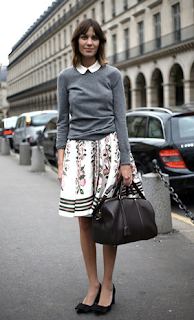Damask is generally a floral pattern formed by weaving on fabrics such as; silk, wool, linen, cotton and other synthetic fibres. It uses one of the five basic techniques of weaving popularized by the Byzantine and Islamic empires during the Middle Ages. Its name comes from where it originated, in Damascus. This city was a bustling hub for trading and manufacturing damask fabrics. By the 14th century damasks made their way west and were being loomed in Italy. They are usually woven from one colour but two colour damasks are common and add an interesting dimension to the pattern. Damask patterns are found in current fashion trends. Clements Ribeiro's fall/winter 2011 collection includes damask prints that fade into another contrasting print. This print is popular in interior design as well and can be found on bedsheets, wallpaper and other forms of interior decorations.
History of Fashion
fashion concepts/garments/styles throughout history
Monday, 2 January 2012
Sunday, 21 August 2011
Collar Me
A collar is a piece of material that shapes the neck of a shirt, dress, tunic or coat. While the collar is normally attached to the body of the garment, within the last few years it has become popular in women's' fashion to wear a detached collar as an accessory. This is evident from fashion houses Miu Miu, Givenchy and a new and upcoming brand called Eleven Objects. However this trend is not entirely new. In the mid- 16th century, collars were often detached from shirts as to allow for starching and embellishment. During the Edwardian period, collars were worn as jewellery.
Sunday, 14 August 2011
IN BLOOM
Bloomers are otherwise known as women's trousers. They were invented by an American woman named Mrs. Bloomer in the mid-19th century. However she was greeted by failure upon their launch in France and England. Towards the end of the 19th century they became known again when they were fashioned from the same material to match little girls' dresses. The trend of underwear worn as outwear saw bloomers emerge into everyday style; seen above at the Miu Miu spring 2008 show. Paired with tights, mary jane pumps and a blouse or sweater the bloomer has transitioned into a mainstream and acceptable concept of dressing.
Monday, 8 August 2011
APRON DRESSING
Aprons are worn to preserve clothing when cooking and dining and often thought of as an unglamorous piece of apparel. In the 17th century it was known as a "laisse tout faire." In the 18th century however the apron reached moderate levels of elegance. It was worn as a vehicle for flirtation during this century when aprons were fashioned from silver and gold lace. The name apron was given to the piece of fabric on the front of a skirt or dress that featured a fabric, print or decoration that differed from the rest of the garment. The apron could feature fine embroidery or could be completely plain if the underlying garment was a complicated pattern.
Subscribe to:
Comments (Atom)























